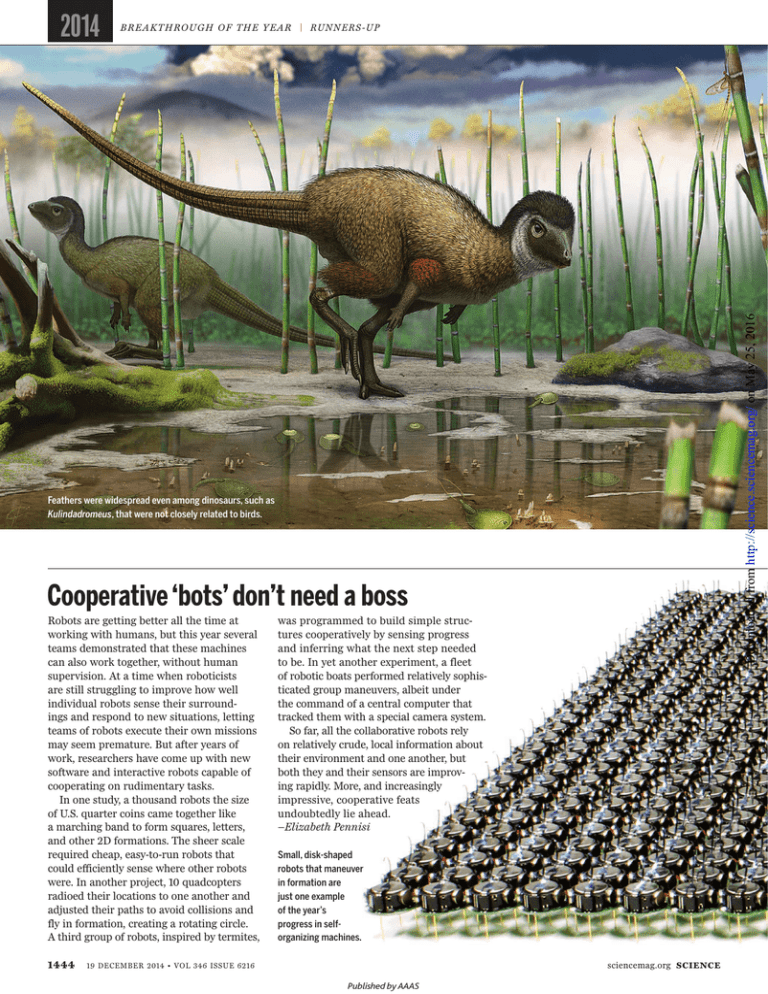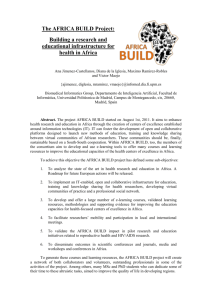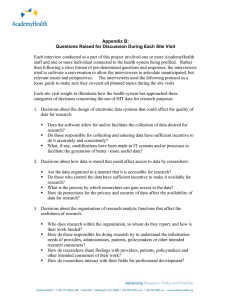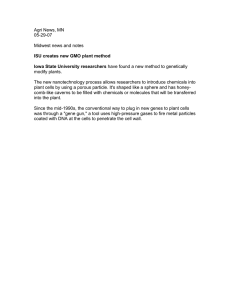2014 Cooperative ‘bots’ don’t need a boss on May 25, 2016
advertisement

B R E A K T H ROU G H O F T H E Y E A R | RUNNERS - UP Downloaded from http://science.sciencemag.org/ on May 25, 2016 2014 Feathers were widespread even among dinosaurs, such as Kulindadromeus, that were not closely related to birds. Cooperative ‘bots’ don’t need a boss Robots are getting better all the time at working with humans, but this year several teams demonstrated that these machines can also work together, without human supervision. At a time when roboticists are still struggling to improve how well individual robots sense their surroundings and respond to new situations, letting teams of robots execute their own missions may seem premature. But after years of work, researchers have come up with new software and interactive robots capable of cooperating on rudimentary tasks. In one study, a thousand robots the size of U.S. quarter coins came together like a marching band to form squares, letters, and other 2D formations. The sheer scale required cheap, easy-to-run robots that could efficiently sense where other robots were. In another project, 10 quadcopters radioed their locations to one another and adjusted their paths to avoid collisions and fly in formation, creating a rotating circle. A third group of robots, inspired by termites, 1444 was programmed d to build simple structures cooperatively ly by sensing progress and inferring what at the next step needed to be. In yet another her experiment, a fleet of robotic boats performed erformed relatively sophisticated group maneuvers, neuvers, albeit under the command of a central computer that tracked them with h a special camera system. So far, all the collaborative ollaborative robots rely on relatively crude, e, local information about their environmentt and one another, but both they and their ir sensors are improving rapidly. More, and increasingly impressive, cooperative erative feats undoubtedly lie ahead. –Elizabeth Pennisi si Small, disk-shaped robots that maneuver er in formation are just one example of the year’s progress in selforganizing machines. sciencemag.org SCIENCE 19 DECEMBER 2014 • VOL 346 ISSUE 6216 Published by AAAS It took a lot to turn lumbering cousins of Tyrannosaurus rex into agile hummingbirds and graceful swans. This year, evolutionary biologists figured out the mode and tempo of the spectacular evolutionary transition from dinosaurs to birds. Their analyses top off 2 decades of fossil discoveries, primarily in China, showing that birdlike innovations— particularly feathers—emerged repeatedly among dinosaurs, well before the first birds appeared. Feathers, it seems, were not just for flying, but also for insulation, display, or possibly balance. In 2014, several groups compiled and analyzed data on many dinosaur and early bird fossils as well as on extant birds, to see when other birdlike traits actually appeared. One study compared 850 morphological traits among 150 species; another measured the thickness of leg bones of 426 species. They discovered that the dinosaurs that ultimately gave rise to birds steadily got smaller and finer boned over time. Once the bird body plan crystallized, new avian species arose quite rapidly, probably because their small size enabled them to find food and shelter that their larger kin could not exploit. Birds took off, but their dinosaur ancestors had given them a running start. –Elizabeth Pennisi Youth serum for real? This year, in work with profound implications for aging, researchers showed that OLD blood or blood components from a young BLOOD mouse can rejuvenate an old mouse’s muscles and brain. If the results hold up in people—an idea already in testing— factors in young blood could offer the antidote to aging that humanity has sought as far back as Juan Ponce de León’s quest for the Fountain of Youth. These findings grew out of strangeYOUNG sounding experiments dating back 150 BLOOD years, in which researchers sew together the skins of two mice to join their 2 circulation. In the early 2000s, the approach was revived to study stem cells. Researchers found that when they connected the circulation of young and old mice, the muscle stem cells in the old mice Old mice thrive when their were better able to regenerate muscle. circulatory systems are linked Work published in 2014 strengthened the with those of younger mice, evidence that something in young blood can for reasons not yet clear. reverse multiple signs of aging. One group studied a factor isolated from young mouse blood called GDF11, which had already been shown to rejuvenate the heart. They found that it can also boost the muscle strength and endurance of an old mouse and spur neuron growth in the brain. Another team reported that young blood, or even cell-free blood plasma, bolsters an aging mouse’s spatial memory. Now, in the first clinical trial, 18 middle-aged and elderly Alzheimer’s patients are receiving injections of plasma donated by young adults. By this time next year, we may know if young blood can fight one of the most feared diseases of aging. –Jocelyn Kaiser SCIENCE sciencemag.org 19 DECEMBER 2014 • VOL 346 ISSUE 6216 Published by AAAS 1445 Downloaded from http://science.sciencemag.org/ on May 25, 2016 IMAGES: (OPPOSITE) ANDREY ATUCHIN; (RIGHT) G. GRULLÓN/SCIENCE; (BOTTOM) MICHAEL RUBENSTEIN, HARVARD UNIVERSITY/WYSS INSTITUTE The birth of birds B R E A K T H ROU G H O F T H E Y E A R | RUNNERS - UP Chips that mimic the brain John von Neumann may have finally met his match. Nearly 70 years ago, the Hungarian-born polymath sketched out the basic design of modern computers, with separate processing, memory, and control units. But this year, computer engineers at IBM and other companies rolled out a promising alternative: the first large-scale “neuromorphic” chips, designed to process information in ways more akin to living brains. Chips based on von Neumann’s architecture excel at carrying out sequences of logical operations, such as those that underlie spreadsheets and word processors. But they struggle with tasks that integrate vast amounts of data, such as vision. Our brains take a very different approach. Individual neurons communicate with thousands of their neighbors through chemical signals, enabling the brain to process lots of information in parallel. Different brain regions also specialize for greater efficiency. The brain’s network of 100 billion cells linked by 100 trillion synapses still dwarfs anything neuromorphic chips can muster. But IBM’s new TrueNorth chip includes 5.4 billion transistors and 256 million “synapses,” and the company is working to tile multiple TrueNorths together to build more complex networks. In the future, brainlike processors could transform fields such as machine vision and environmental monitoring, integrating real-time data from sensors from around the globe. –Robert F. Service Early artists blew red pigment over their hands to create this cave art on the island of Sulawesi at least 40,000 years ago. Downloaded from http://science.sciencemag.org/ on May 25, 2016 2014 “Neuromorphic” chips inspired by networks of brain cells may excel at data-intensive tasks such as vision. Since the discovery of human embryonic stem (ES) cells, researchers have hoped to wield them against disease. The quest has been frustratingly slow. For more than a decade, for 4 example, labs all over the world have sought to turn ES cells into cells of the pancreas called β cells. β cells respond to rising blood sugar by making insulin, a hormone that allows cells to take up and use glucose. An autoimmune attack that kills β cells leads to type 1 diabetes; replacing them with lab-grown cells might provide a cure. This year, researchers came closer than ever to that goal, when two groups published methods for growing cells that resemble human β cells. 1446 sciencemag.org SCIENCE 00 MONTH 20XX • VOL XXX ISSUE XXXX Published by AAAS IMAGES: (LEFT TO RIGHT) JOE LERTOLA, BRYAN CHRISTIE DESIGN; KINEZ RIZA Cells that might cure diabetes PHOTO: DOUGLAS MELTON For decades, visitors have marveled at the prehistoric graffiti that fills the Maros caves on the island of Sulawesi, Indonesia: hand stencils outlined in mouthblown red paint, mixed with pictures of rare “pig-deer” in red and mulberry hues. This year they evoked an extra measure of wonder. Scientists discovered that the images, thought to be about 10,000 years old, are actually four times older—at least as ancient as the famous cave art in Europe. The finding could rewrite the history of a key stage in the development of the human mind. People in Africa engraved geometric designs on chunks of hematite and on ostrich eggshells as early as 78,000 years ago. But symbolic art first seemed to blossom between 35,000 and 39,000 years ago in Europe, where artists painted vivid representations of rhinos, horses, lions, and women, notably at Chauvet Cave in France. Some archaeologists argued that the European creative explosion reflected a new leap in human abilities, but others thought the capacity for symbolic expression had already developed in Africa, before modern humans left that continent to populate the world. The new dates in Indonesia end Europe’s monopoly on early symbolic art. By measuring the radioactive decay of uranium in small stalactitelike growths that formed atop the paintings, Australian and Indonesian researchers found that the oldest hand stencil is at least 39,900 years old and the animal paintings at least 35,400. If the numbers are accurate, they suggest that humans in Indonesia independently invented symbolic art as early as Europe’s cave painters did— or that modern humans were already sophisticated artists when they spread out of Africa starting about 60,000 years ago. –Ann Gibbons One approach works with both ES cells and so-called induced pluripotent stem cells—reprogrammed cells that can be made from a patient’s skin cells. The recipe is complex, and it takes 7 weeks to convert stem cells into the insulinproducing cells. But researchers can grow 200 million of the β-like cells in a 500-ml flask—in theory, enough to treat a patient. The other method takes 6 weeks and can produce one β-like cell for every two ES cells at the start. To use the cells to treat type 1 diabetes, researchers need to develop ways of protecting them from the autoimmune reaction that kills β cells in the first place. Meanwhile, the grown-to-order cells give scientists an unprecedented chance to study diabetes in the lab. Researchers have already started to compare β cells made from skin cells of healthy subjects with those made from patients with diabetes, hoping to pinpoint the key differences. –Gretchen Vogel Human pancreatic β cells made in the lab produce enough insulin (green) to cure a diabetic mouse 2 weeks after transplant. SCIENCE sciencemag.org 19 DECEMBER 2014 • VOL 346 ISSUE 6216 Published by AAAS 1447 Downloaded from http://science.sciencemag.org/ on May 25, 2016 Europe’s cave art has a rival B R E A K T H ROU G H O F T H E Y E A R | RUNNERS -U P Giving life a bigger genetic alphabet Everywhere on Earth, the genetic code at the heart of living things consists of the same four genetic letters. Everywhere, 1 that is, except in a flask of Escherichia coli bacteria on a lab bench in southern California. There, researchers this year engineered the bacteria to incorporate two additional letters into their genetic alphabet. In addition to the natural nucleotides, 1448 Memory is notoriously malleable. Our recollections fade and take on new meanings; sometimes we remember things that never even happened. But just what is happening in our brain as memories are remodeled remains mysterious. Recently, however, scientists have started to grasp and tinker with memory’s physical basis. Last year, in work evocative of films such as Eternal Sunshine of the Spotless Mind and Inception, researchers discovered ways to manipulate specific memories in mice using optogenetics, a powerful technique that can trigger nerve cells in animals’ brains by zapping them with beams of laser light. In a series of experiments, they showed that they could delete existing memories and “incept” false ones. This year, researchers went even further: switching the emotional content of a memory in mice from bad to good and vice versa. Under the laser, for example, male mice that had once associated a certain room with being shocked were tricked into acting as though they had once met friendly female mice there instead. Whether the mice in these experiments actually experienced vivid false memories or just a fuzzy sense of pleasure or fear is unclear. Nor is it clear whether the findings apply to the tricks of memory so familiar to people. Long-sought therapeutic advances, such as treatments for post-traumatic stress disorder, could remain far off. One thing is certain, however: Once considered beyond scientific dissection, memory is finally starting to yield its secrets. –Emily Underwood in which G pairs with C and A pairs with T, the bacterial DNA includes a novel pair: X and Y. Researchers around the globe had already devised several pairs of “unnatural” nucleotide bases that, in the test tube, could fit within DNA’s double helix. They also managed to get DNA’s copying machine, an enzyme known as DNA polymerase, to copy some of these new pairs. But no one had ever made it all happen inside living organisms—until this year. For now, the new letters in the E. coli DNA don’t code for anything, but in principle, researchers could use them to create designer proteins that include “unnatural” building blocks: amino acids beyond the 20 encoded by the bases in normal DNA. Researchers have previously used genetic tricks to do that with natural DNA. But adding the new X-Y combo should make the process far easier. That could be a godsend for makers of medicines and materials. And perhaps not the only one: This year, in a parallel effort to tailor DNA, synthetic biologists also modified its chemistry to create novel catalysts. Eventually, the expanded genetic code sciencemag.org SCIENCE 19 DECEMBER 2014 • VOL 346 ISSUE 6216 Published by AAAS Downloaded from http://science.sciencemag.org/ on May 25, 2016 Manipulating memory By zapping the brain cells of mice with light, researchers can create, erase, or alter memories. PHOTO: KARL DEISSEROTH, JOHN CARNETT, VIVIANA GRADINARU 2014 Scorecard for 2014 Every year, the Breakthrough staff picks scientific developments likely to make news in the coming months. The numbers of bars show how last year’s forecasts fared; those for 2015 are on page 1450. The rise of the CubeSat A decade ago, CubeSats were just educational tools, a way for university students to place a simple Sputnik in space. Now these 10-centimeter boxes, built with off-the-shelf technology and costing hundreds of thousands of dollars rather than hundreds of millions, have taken off. More than 75 were launched this year, a record. What’s more, the little boxes are starting to do real science. Increased and affordable access to space is driving much of the boom. CubeSats can hitch a ride on commercial or government rockets carrying bigger spacecraft, or they can be pushed out the door of the International Space Station. The rapid-fire launch rate is encouraging something never before seen in space: risk-taking. Designers can tolerate a failure or two and quickly get back in the game. As technology advances, they can also swap in better solar panels, batteries, or processors. Private money has taken notice, funding companies such as Planet Labs, which is monitoring Earth with a swarm of perennially replaced CubeSats. Their small telescopes take pictures with relatively poor spatial resolution—a few meters—but at frequent intervals. Spy agencies may not be seduced, but Planet Labs’ data are plenty useful for monitoring deforestation, urban development, and river changes. Coming up next: CubeSats that talk to one another while taking measurements. Among other things, such CubeSat constellations will be able to cover more area, faster, or monitor Earth’s surface in several wavelengths at once. If they work, CubeSats will have demonstrated not only that small is beautiful, but also that the whole is greater than the sum of its parts. –Eric Hand Expanded DNA Expanded RNA 6 nucleotides, 3 base pairs 6 nucleotides A T A C G C Y X Y T A U X X Y G could also serve a more academic pursuit, enabling researchers to test whether bacteria equipped with the excess letters might evolve novel skills not found in their wild kin. That may sound like a scenario for a dystopian techno-thriller, but the researchers say there’s no need to worry: Because unnatural DNA letters don’t exist outside the lab, any bacterial escapees would not be able to replicate their artificially expanded genetic instructions and pass them on to their offspring. –Robert F. Service SCIENCE sciencemag.org SPACE GHOSTS Last year, physicists with IceCube, a massive neutrino detector deep in the ice at the South Pole, spotted high-energy neutrinos from beyond our solar system. But could IceCube track enough to pinpoint their mysterious sources? We predicted the IceCube team would release search results this year, and in November, it did—but didn’t nail down any obvious sources. CLINICAL GENOMES Tests that sequence a patient’s proteincoding DNA (the exome) or entire genome to uncover disease-causing glitches are fast becoming routine for rare disorders. Whole genome or exome sequencing to identify tumor mutations remains largely a research endeavor, however. COSMIC HISTORY, WITH A TWIST We predicted that cosmologists mapping the afterglow of the big bang might spot swirls that would be a telltale sign that in the first sliver of a second the universe underwent an exponential growth spurt called inflation. In March, one team claimed just such a sighting, but by September another had shown that the signal may be entirely spurious (see breakdown runners-up, p. 1451). BYE-BYE, CHIMPS? Chimpanzees still live in U.S. research labs, but efforts continue to grant them “legal personhood”—and the right to be free. The Nonhuman Rights Project lost all three of the lawsuits it launched last year to try to free four New York chimps—including two lab chimps—from captivity. This year, it appealed each case and now has its sights set on the state’s highest court. 19 DECEMBER 2014 • VOL 346 ISSUE 6216 Published by AAAS 1449 Downloaded from http://science.sciencemag.org/ on May 25, 2016 IMAGES: (CLOCKWISE FROM TOP LEFT) NASA; SVEN LIDSTROM/ICECUBE/NSF; SYNTHORX, ADAPTED BY C. SMITH/SCIENCE Two Earth-observing CubeSats (dark oblong objects) shoot from a satellite deployment device on the International Space Station. Runners-up (December 18, 2014) Science 346 (6216), 1444-1449. [doi: 10.1126/science.346.6216.1444] This copy is for your personal, non-commercial use only. Article Tools Permissions Visit the online version of this article to access the personalization and article tools: http://science.sciencemag.org/content/346/6216/1444 Obtain information about reproducing this article: http://www.sciencemag.org/about/permissions.dtl Science (print ISSN 0036-8075; online ISSN 1095-9203) is published weekly, except the last week in December, by the American Association for the Advancement of Science, 1200 New York Avenue NW, Washington, DC 20005. Copyright 2016 by the American Association for the Advancement of Science; all rights reserved. The title Science is a registered trademark of AAAS. Downloaded from http://science.sciencemag.org/ on May 25, 2016 Editor's Summary



